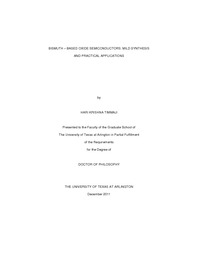
ATTENTION: The works hosted here are being migrated to a new repository that will consolidate resources, improve discoverability, and better show UTA's research impact on the global community. We will update authors as the migration progresses. Please see MavMatrix for more information.
Show simple item record
| dc.contributor.author | Timmaji, Hari Krishna | en_US |
| dc.date.accessioned | 2012-04-11T20:59:28Z | |
| dc.date.available | 2012-04-11T20:59:28Z | |
| dc.date.issued | 2012-04-11 | |
| dc.date.submitted | January 2011 | en_US |
| dc.identifier.other | DISS-11358 | en_US |
| dc.identifier.uri | http://hdl.handle.net/10106/9637 | |
| dc.description.abstract | In this dissertation study, bismuth based oxide semiconductors were prepared using 'mild' synthesis techniques - electrodepostion and solution combustion synthesis. Potential environmental remediation and solar energy applications of the prepared oxides were evaluated. Bismuth vanadate (BiVO₄) was prepared by electrodeposition and solution combustion synthesis. A two step electrosynthesis strategy was developed and demonstrated for the first time. In the first step, a Bi film was first electrodeposited on a Pt substrate from an acidic BiCl₃ medium. Then, this film was anodically stripped in a medium containing hydrolyzed vanadium precursor, to generate Bi3+, and subsequent BiVO₄ formation by in situ precipitation. The photoelectrochemical data were consistent with the in situ formation of n-type semiconductor films. In the solution combustion synthesis procedure, BiVO₄ powders were prepared using bismuth nitrate pentahydrate as the bismuth precursor and either vanadium chloride or vanadium oxysulfate as the vanadium precursor. Urea, glycine, or citric acid was used as the fuel. The effect of the vanadium precursor on the photocatalytic activity of combustion synthesized BiVO₄ was evaluated in this study. Methyl orange was used as a probe to test the photocatalytic attributes of the combustion synthesized (CS) samples, and benchmarked against a commercial bismuth vanadate sample. The CS samples showed superior activity to the commercial benchmark sample, and samples derived from vanadium chloride were superior to vanadium oxysulfate counterparts. The photoelectrochemical properties of the various CS samples were also studied and these samples were shown to be useful both for environmental photocatalytic remediation and water photooxidation applications. Silver bismuth tungstate (AgBiW₂O₈) nanoparticles were prepared for the first time by solution combustion synthesis by using silver nitrate, bismuth nitrate, sodium tungstate as precursors for Ag, Bi, and W respectively and urea as the fuel. The photocatalytic activity of these nanoparticles was superior to a sample prepared by solid-state synthesis. The combustion-synthesized particles were subsequently modified with Pt catalyst islands using a photodepostion technique and then used for the photo-generation of syngas (CO + H₂). Formic acid was used in these experiments for in situ generation of CO₂ and its subsequent reduction to CO. In the absence of Pt modification, H₂ was not obtained. These results were compared with those obtained with acetic acid in place of formic acid, and finally the mechanistic pathways for syngas and methane photogeneration are presented. | en_US |
| dc.description.sponsorship | Rajeshwar, Krishnan | en_US |
| dc.language.iso | en | en_US |
| dc.publisher | Environmental & Earth Science | en_US |
| dc.title | Bismuth-based Oxide Semiconductors: Mild Synthesis And Practical Applications | en_US |
| dc.type | Ph.D. | en_US |
| dc.contributor.committeeChair | Rajeshwar, Krishnan | en_US |
| dc.degree.department | Environmental & Earth Science | en_US |
| dc.degree.discipline | Environmental & Earth Science | en_US |
| dc.degree.grantor | University of Texas at Arlington | en_US |
| dc.degree.level | doctoral | en_US |
| dc.degree.name | Ph.D. | en_US |
Files in this item
- Name:
- Timmaji_uta_2502D_11358.pdf
- Size:
- 3.536Mb
- Format:
- PDF
This item appears in the following Collection(s)
Show simple item record


